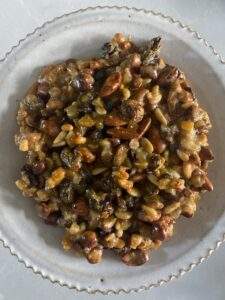pangiallo with saffron glaze
Rachel Roddy’s wonderful Five Quarters has a gem of a recipe for pangiallo which means “yellow bread” in Italian. Our fragrant Lebanese saffron creates a sunny glaze for the “cake”, to remind us that spring is just round the corner.
Although pangiallo means “yellow bread” this isn’t a bread, nor is it a cake. But perhaps closest to a panforte – packed with nuts and fruit, beautifully spiced with nutmeg – it’s chewy, crunchy and quite the most delicious thing with a cuppa in the afternoon, or as a rather elegant “sweetmeat” alongside coffee at the end of a meal.
Pangiallo has roots in ancient Rome, and is said to mark the winter solstice, the end of the long winter days, the saffron glaze evoking the sun, heralding the arrival of warmer days.
Zejd’s saffron is very aromatic, and gives an intense colour when left to infuse in a tablespoon of warm water. If you do have a pestle and mortar, grinding the saffron is a more effective way of releasing aroma and colour. Both saffron and nutmeg together are gloriously aromatic combination, particularly as the cakes cook in the oven. The recipe is a wonderful way of using up any lingering Christmas nuts and left-over candied peel. Feel free to choose any vine fruit, just make sure you really do grate 1/2 a nutmeg – time well spent.
We halved the quantities of the saffron glaze from the original recipe but it still made enough to glaze both cakes. Our thanks to Rachel Roddy for allowing this adaptation of her recipe from Five Quarters.
makes 2 small cakes about 8-10 slices
ingredients
100g sultanas
100g dried figs
150g candied fruit or chopped peel
200g mixed nuts, such as almonds, pine nuts, hazelnuts and walnuts, roughly chopped
100g plain flour
1/2 whole nutmeg, grated
a pinch of cinnamon
1/2 tsp black pepper
150g honey
80g icing sugar
for the saffron glaze
1/4 of a teaspoon of Zejd’s saffron
1 tablespoon of warm water
2 egg yolks
1 tbsp flour
1 tbsp icing sugar
method
- Begin by placing the saffron in a small bowl and infusing with the hot water while you get on with the rest of the recipe.
- Soak the sultanas (or other vine fruit) in a little hot water for 10 minutes to plump them up a bit.
- Chop the figs into eighths and dice the candied fruit if in larger pieces.
- Once the sultanas are plump, drain and squeeze any excess water.
- In a large bowl, mix together all the dried fruit and nuts, then add the flour, nutmeg, cinnamon and pepper.Stir well so that everything is well coated.
- Preheat the oven 170 C/ 150 C fan/gas mark 3.Line a baking tray with baking paper.
- In a small pan, warm the honey with a tablespoon of water and add the icing sugar stirring until it bubbles at the side of the pan.
- Pour this over the nut mixture in the bowl and stir until well combined and there are no traces of flour.
- Divide in half, and form into 2 round shapes approximately 3cm deep and 15cm wide. Place on the prepared baking tray.
- Make the glaze by grinding the saffron in a pestle and mortar to allow the colour to infuse better. Then add the warm water to the saffron and leave for 10 minutes to infuse. Add the egg yolks, flour and sifted icing sugar. Beat until the mixture is smooth. Using a pastry brush, dab the mixture on to the tops of the cakes. Or if the mixture is runny just pour it on over the top. The glaze won’t be so visible, but you’ll still enjoy the flavour of the saffron with the nutmeg. Bake for 30 minutes, or until firm and golden at the edges. Leave to cool before slicing into smallish pieces.
